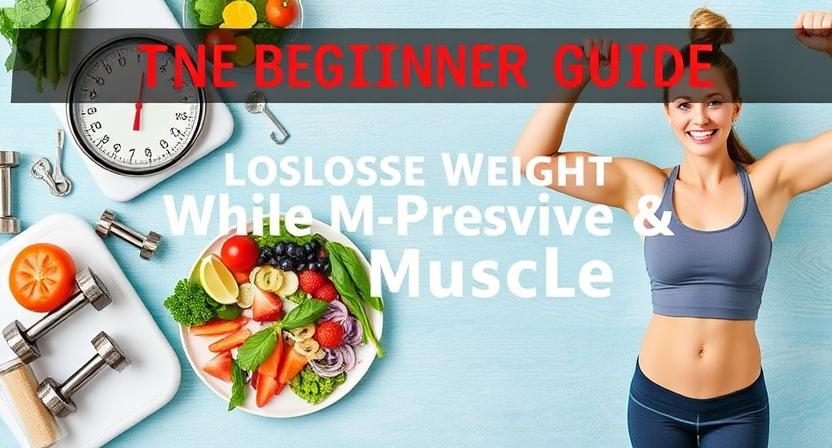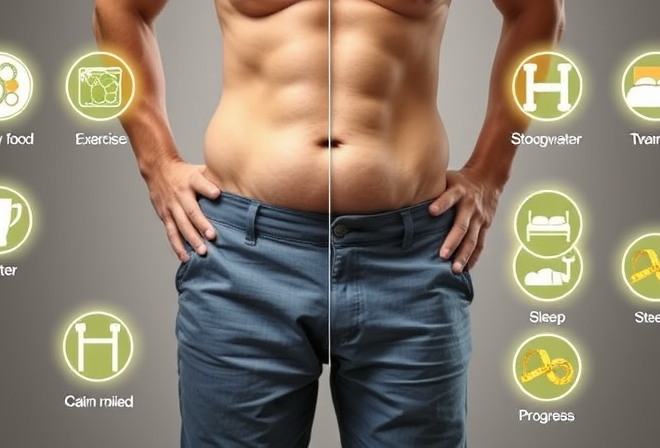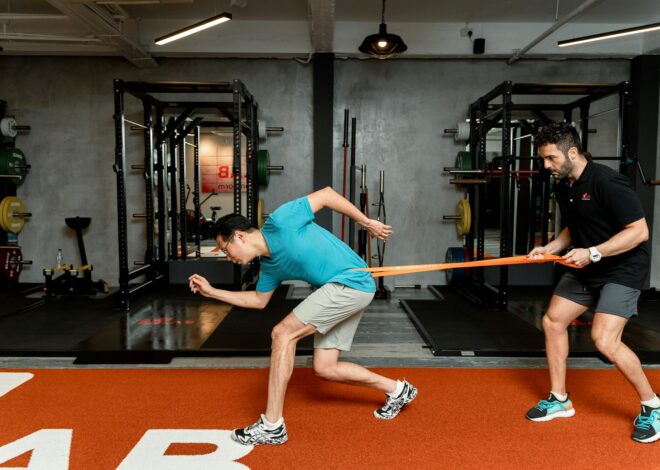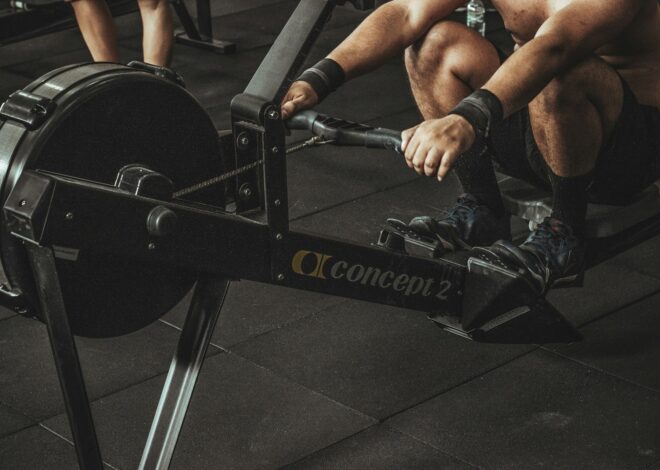
How to Lose Weight Without Sacrificing Muscle: A Beginner’s Guide
Why Maintaining Muscle Mass is Important for Weight Loss

Maintaining muscle mass is crucial for weight loss due to its impact on boosting metabolism. Muscle tissue is more metabolically active than fat, meaning that the more muscle you have, the more calories your body will burn at rest. By incorporating strength training exercises into your routine, you can increase your muscle mass and in turn, raise your resting metabolic rate, making it easier to achieve and maintain a healthy weight. Additionally, preserving muscle mass during weight loss helps to prevent the loss of muscle tissue that can occur when calorie intake is reduced, ensuring that the weight lost comes primarily from fat stores.
Furthermore, maintaining muscle mass plays a key role in shaping your body composition during weight loss. While losing weight, it is common for individuals to experience a decrease in both fat mass and lean muscle mass. By engaging in regular strength training workouts, you can help to preserve your muscle mass and promote a leaner, more toned appearance as you shed excess body fat. This not only enhances the aesthetic results of weight loss but also contributes to improved strength, balance, and overall physical function.
Understanding the Basics of Weight Loss and Muscle Preservation
When embarking on a weight loss journey, it is essential to understand the basics of muscle preservation. Many people focus solely on losing weight without considering the impact on their muscle mass. However, preserving muscle is crucial for maintaining a healthy metabolism and achieving long-term weight loss success. Muscles are metabolically active tissue that helps burn calories, even at rest. Therefore, losing muscle mass can slow down your metabolism, making it harder to lose weight and easier to regain it.
Incorporating strength training into your workout routine is key to preserving muscle mass while shedding excess weight. Strength training not only helps you build lean muscle but also improves your overall strength and endurance. By challenging your muscles with resistance exercises, you can prevent muscle loss while promoting fat loss. Additionally, strength training can enhance your body composition, giving you a leaner and more toned appearance as you progress towards your weight loss goals.
Setting Realistic and Achievable Weight Loss Goals
When setting weight loss goals, it’s crucial to be realistic and practical. Oftentimes, people try to achieve rapid results, but sustainable progress takes time and consistency. Rather than aiming for drastic changes in a short period, focus on making gradual improvements to your habits and lifestyle. This approach not only leads to more lasting results but also promotes a healthier relationship with food and exercise.
It can be helpful to break down your ultimate weight loss goal into smaller, more manageable milestones. By setting achievable targets along the way, you can track your progress and stay motivated. Celebrating these smaller victories can boost your confidence and keep you on track towards your long-term success. Remember, incremental progress is still progress, and each step forward, no matter how small, is a step closer to reaching your ultimate weight loss goals.
The Role of Cardiovascular Exercise in Weight Loss
Cardiovascular exercise plays a crucial role in weight loss by increasing calorie expenditure and promoting fat loss. Engaging in activities like running, cycling, or swimming can elevate your heart rate, aiding in the burning of excess calories. Regular cardio sessions not only contribute to weight loss but also improve overall cardiovascular health, enhancing endurance and stamina.
Incorporating cardiovascular exercise into your routine can also help boost your metabolism, leading to more efficient calorie burning throughout the day. Whether it’s a brisk walk during your lunch break or a high-intensity interval training session, each bout of cardio contributes to creating a caloric deficit necessary for weight loss. Additionally, cardio workouts can elevate mood and reduce stress, creating a positive cycle that supports your weight loss journey.
Incorporating Strength Training for Muscle Maintenance
Strength training plays a crucial role in preserving muscle mass during weight loss journeys. By engaging in resistance exercises such as lifting weights or using bodyweight movements, individuals can prevent muscle loss while shedding excess fat. Incorporating a variety of strength training exercises that target different muscle groups helps maintain overall muscle mass and strength.
Consistency is key when it comes to strength training for muscle maintenance. Aim to include resistance workouts into your weekly routine on a regular basis to reap the benefits of preserving muscle mass. Gradually increasing the intensity and complexity of your strength training sessions can also help challenge your muscles and prevent plateauing in your progress.
Balancing Your Macronutrient Intake for Weight Loss and Muscle Preservation

To effectively support weight loss and muscle preservation, it is essential to pay attention to the balance of macronutrients in your diet. Macronutrients, which include carbohydrates, proteins, and fats, each play a crucial role in fueling your body and aiding in muscle recovery and growth. By ensuring that you are consuming a balanced mix of these macronutrients, you provide your body with the necessary building blocks to support your goals.
Carbohydrates are a primary source of energy for your muscles, especially during high-intensity workouts or strength training sessions. Including complex carbohydrates such as whole grains, fruits, and vegetables in your diet can help sustain your energy levels and support muscle function. Proteins, on the other hand, are essential for muscle repair and growth. Including lean sources of protein such as chicken, fish, tofu, or legumes in your meals can help maintain muscle mass while promoting fat loss. Additionally, incorporating healthy fats from sources like nuts, seeds, avocados, and olive oil can support overall health and aid in nutrient absorption. Balancing these macronutrients in your diet can help optimize your weight loss journey while preserving valuable muscle mass.
Eating Enough Protein to Support Muscle Growth and Repair
Protein plays a crucial role in supporting muscle growth and repair. When aiming to lose weight, it’s essential to ensure that you are consuming an adequate amount of protein to maintain your muscle mass. Protein contains amino acids, which are the building blocks of muscle tissue. By supplying your body with enough protein, you provide it with the necessary nutrients to repair and strengthen muscles after workouts. This not only helps preserve your existing muscle mass but can also aid in the development of lean muscle as you progress in your weight loss journey.
Incorporating protein-rich foods into your meals and snacks can help you meet your daily protein requirements. Sources of protein include lean meats, poultry, fish, eggs, dairy products, legumes, nuts, and seeds. Including a variety of these protein sources in your diet can ensure that you are getting a balanced mix of essential amino acids needed for optimal muscle growth and repair. Additionally, incorporating protein into your meals can help you feel fuller for longer, reducing the likelihood of overeating and supporting your weight loss efforts.
The Importance of Hydration in Weight Loss and Muscle Preservation
Staying well-hydrated is crucial for both weight loss and muscle preservation. Water plays a vital role in various bodily functions, including metabolism and nutrient transport. Proper hydration can help boost your energy levels, improve exercise performance, and aid in recovery after workouts.
Additionally, drinking an adequate amount of water can support muscle growth and repair by ensuring optimal nutrient delivery to muscle cells. Dehydration can lead to decreased muscle function and hinder your progress in the gym. By staying hydrated throughout the day, you can support your weight loss efforts and maintain your muscle mass more effectively.
Getting Sufficient Rest and Recovery for Optimal Muscle Preservation
Rest and recovery play a crucial role in preserving muscle mass during weight loss. When you engage in intense workouts or strength training sessions, tiny tears occur in your muscle fibers. It is during rest that these fibers repair and grow stronger, contributing to muscle maintenance and development. Adequate sleep is equally vital, as it is during deep sleep cycles that the body releases growth hormone, essential for repairing and rebuilding muscle tissue. Therefore, ensure you prioritize both rest and quality sleep to optimize muscle preservation and overall well-being.
In addition to sleep, active recovery techniques like stretching, yoga, or light cardio can help increase blood flow to the muscles, aiding in their repair. Including rest days in your workout routine allows your muscles to recover, adapt, and grow in response to the stress placed upon them. By listening to your body’s signals and giving it the time it needs to recover, you can prevent overtraining, reduce the risk of injury, and support the long-term preservation of your hard-earned muscle mass.
Avoiding Crash Diets and Extreme Caloric Restrictions
Pursuing rapid weight loss through crash diets and extreme caloric restrictions may seem tempting for quick results, but the long-term implications can be detrimental to your overall health. Drastically reducing your caloric intake can lead to nutrient deficiencies, slowed metabolism, muscle loss, and increased risk of binge eating episodes. These approaches are often unsustainable and can hinder your progress in the long run.
Instead of resorting to drastic measures, it is important to focus on creating a balanced and sustainable approach to weight loss. By making gradual changes to your diet and exercise routine, you can achieve lasting results without compromising your health. Building healthy habits that you can maintain over time will not only support your weight loss goals but also contribute to your overall well-being and longevity.
Strategies for Tracking Your Progress and Adjusting Your Plan

When embarking on a weight loss journey, tracking your progress is crucial for staying on course and making informed adjustments to your plan. Keeping a detailed record of your workouts, dietary intake, and measurements can provide valuable insights into what is working well and where improvements can be made. By regularly assessing your progress, you can identify patterns, setbacks, or areas that may need tweaking to optimize your results.
In addition to tracking your progress, it is equally important to be proactive in adjusting your plan as needed. If you notice a plateau in weight loss or stagnation in muscle growth, it may be time to reassess your exercise routine or nutritional habits. Making small, sustainable changes based on the data you have collected can help you continue making progress towards your goals. Remember that flexibility and adaptability are key components of a successful weight loss journey, so don’t hesitate to modify your plan when needed to keep moving forward.
Utilizing High-Intensity Interval Training (HIIT) for Efficient Fat Loss
High-Intensity Interval Training (HIIT) has gained popularity for its effectiveness in promoting efficient fat loss. This form of exercise involves alternating short bursts of intense activity with brief periods of rest or lower intensity exercise. HIIT workouts are known for their time efficiency and ability to maximize calorie burn both during and after the workout, a phenomenon known as the afterburn effect. By pushing your body to its limits in short intervals, HIIT can help increase your metabolic rate and improve your overall cardiovascular health.
Incorporating HIIT sessions into your fitness routine can help you break through plateaus and see results more quickly than traditional steady-state cardio exercises. HIIT workouts can be tailored to your fitness level and goals, making them accessible to beginners and seasoned athletes alike. Whether you’re looking to shed stubborn fat, improve your endurance, or boost your overall fitness, incorporating HIIT into your regimen can be a valuable tool in your weight loss journey.
Incorporating Compound Movements for Full-Body Muscle Activation
Compound movements are essential for engaging multiple muscle groups simultaneously, making them highly efficient for maximizing your workout time. Exercises like squats, deadlifts, and bench presses not only target primary muscles but also engage stabilizing muscles, enhancing overall strength and muscle activation. Incorporating compound movements into your routine can help improve coordination, balance, and functional fitness, making daily activities easier and reducing the risk of injury.
By incorporating compound movements into your workout regimen, you can achieve a full-body muscle activation that promotes muscle growth and development. These multi-joint exercises not only increase muscle mass but also boost metabolism, aiding in weight loss efforts. The combination of compound movements with targeted exercises can create a well-rounded fitness program that addresses various muscle groups, leading to improved strength, endurance, and overall physical performance.
The Benefits of Functional Training for Muscle Preservation
Functional training is a highly effective approach to maintaining muscle mass while focusing on movements that mimic real-life activities. By engaging multiple muscle groups simultaneously in a functional training routine, individuals can improve their overall strength, mobility, and coordination. This type of training not only helps in preserving existing muscle mass but also aids in preventing injuries by enhancing stability and balance.
Moreover, functional training can be tailored to suit individual fitness levels and goals, making it a versatile option for those looking to preserve muscle while losing weight. By incorporating exercises that target specific muscle groups used in daily tasks, individuals can see improvements in their overall functional capacity, leading to a more efficient and resilient body. Adding functional training to a weight loss regimen can not only help in maintaining muscle mass but also contribute to enhanced performance in various physical activities.
Seeking Professional Guidance from a Certified Trainer or Nutritionist
Embarking on a weight loss journey can be overwhelming, especially with the plethora of information available online. Seeking professional guidance from a certified trainer or nutritionist can provide you with personalized advice tailored to your specific needs and goals. These experts have the knowledge and experience to create a customized plan that takes into account your current fitness level, dietary preferences, and any underlying health conditions. By working closely with a trainer or nutritionist, you can receive valuable insights that can help you optimize your weight loss journey and avoid potential pitfalls along the way.
Additionally, a certified trainer or nutritionist can offer accountability and motivation to keep you on track with your weight loss goals. They can help you stay consistent with your exercise routine, make healthier food choices, and track your progress effectively. With their support and guidance, you can navigate the challenges of weight loss more effectively and feel empowered to make sustainable lifestyle changes. By investing in professional guidance, you are setting yourself up for long-term success and ensuring that your weight loss journey is both effective and enjoyable.
Exploring Supplement Options to Support Your Weight Loss Journey

When it comes to exploring supplement options to support your weight loss journey, it’s important to approach this with caution and research. Supplements can be a helpful addition to your routine, but they should not be relied on as the sole method for achieving your weight loss goals. Consulting with a healthcare provider or nutritionist before incorporating any supplements is a wise step to ensure they align with your individual needs and health status.
Some common supplements that are often considered for weight loss support include protein powders, fish oil, green tea extract, and thermogenic compounds. These supplements may offer benefits such as increased metabolism, improved satiety, and enhanced fat burning. However, it’s crucial to remember that supplements are meant to complement a balanced diet and regular exercise regimen, rather than replace them. Prioritizing whole foods and a well-rounded nutrition plan should always take precedence over relying solely on supplements for weight loss.
Avoiding Comparisons and Focusing on Your Own Progress
In the journey of weight loss and muscle preservation, it can be tempting to compare your progress to others. However, this habit of constant comparison can often lead to feelings of inadequacy or discouragement. Instead of focusing on how your journey measures up to someone else’s, shift your mindset to concentrate on your own progress. Remember that everyone’s path is unique, and what works for one person may not necessarily work for another. By staying focused on your own journey and celebrating your personal victories, big or small, you can maintain a positive outlook and motivation throughout the process.
Comparing yourself to others can create unrealistic expectations and unnecessary pressure. Your journey is about self-improvement and achieving your own goals, not living up to someone else’s standards. By redirecting your energy towards your own progress, you can better appreciate the improvements you have made and stay committed to your long-term success. Embrace the individuality of your journey and use it as a source of motivation to keep pushing forward towards your goals.
• Remember that everyone’s path is unique
• Celebrate your personal victories, big or small
• Comparing yourself to others can create unrealistic expectations and unnecessary pressure
• Your journey is about self-improvement and achieving your own goals
• Redirect your energy towards your own progress
• Appreciate the improvements you have made
• Embrace the individuality of your journey as a source of motivation
Staying Consistent and Patient Throughout Your Weight Loss Journey
Consistency is key when it comes to achieving your weight loss goals. By committing to a regular exercise routine and sticking to a balanced diet, you can gradually progress towards a healthier lifestyle. Remember that lasting changes take time, so be patient with yourself throughout the journey. It’s important to focus on the process rather than just the end result, as sustainable weight loss is about adopting healthy habits for the long term.
Set realistic expectations and understand that weight loss doesn’t happen overnight. Celebrate small victories along the way, such as feeling stronger during workouts or noticing improvements in your energy levels. Stay motivated by tracking your progress and making adjustments as needed to keep moving forward. Trust the process and stay consistent with your efforts, knowing that each step you take is bringing you closer to your ultimate goals.
Celebrating Non-Scale Victories and Small Wins Along the Way
One of the most empowering aspects of a weight loss journey is the recognition and celebration of non-scale victories and small wins along the way. While the number on the scale is a common measure of progress, there are numerous other achievements that deserve acknowledgment. These victories can come in various forms, such as fitting into a pair of jeans that were previously too tight, noticing increased strength and endurance during workouts, or receiving compliments from others who notice your physical or mental transformations.
By shifting the focus from solely relying on the scale to track progress, individuals embarking on a weight loss journey can stay motivated and inspired by the small milestones they achieve. Recognizing these victories not only boosts confidence but also reinforces the importance of consistency and perseverance. Whether it’s resisting temptation to indulge in unhealthy foods, completing a challenging workout, or noticing improvements in overall well-being, celebrating these moments can provide a sense of accomplishment and drive to continue making positive lifestyle changes.
Embracing the Lifestyle Changes Necessary for Long-Term Success
Embracing lifestyle changes is crucial for sustaining long-term success in your weight loss journey. It’s not just about quick fixes or temporary solutions; it’s about adopting habits that promote overall health and well-being. By incorporating healthier choices into your daily routine and making them a natural part of your lifestyle, you’ll not only see progress in your weight loss goals but also experience improved energy levels, mental clarity, and overall vitality.
Successful weight loss is not just about following a strict diet or exercise regimen for a short period. It’s about making sustainable changes that you can maintain for the long term. This may involve finding ways to incorporate healthy foods you enjoy, engaging in physical activities that bring you joy, and prioritizing self-care practices that support your overall health. By embracing these positive lifestyle changes, you’ll not only achieve your weight loss goals but also set yourself up for a lifetime of success and well-being.













